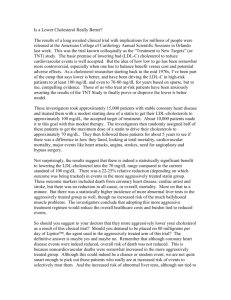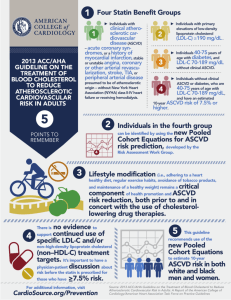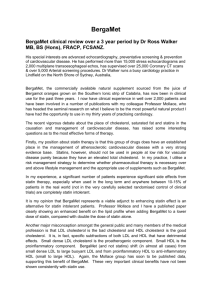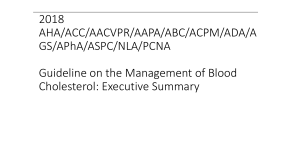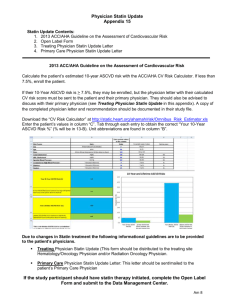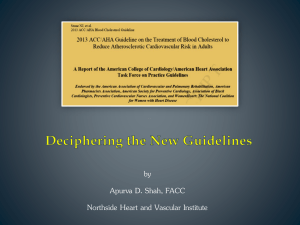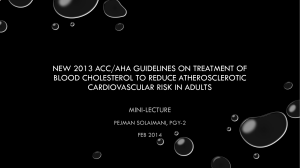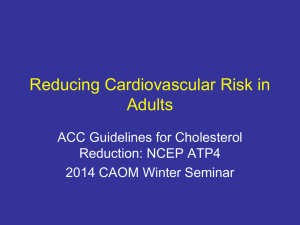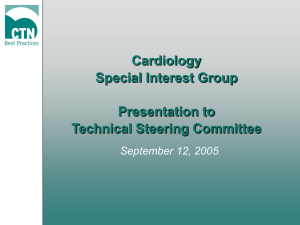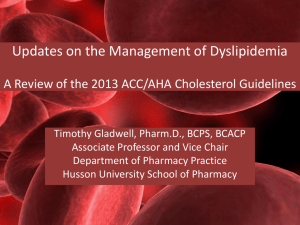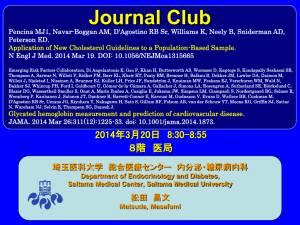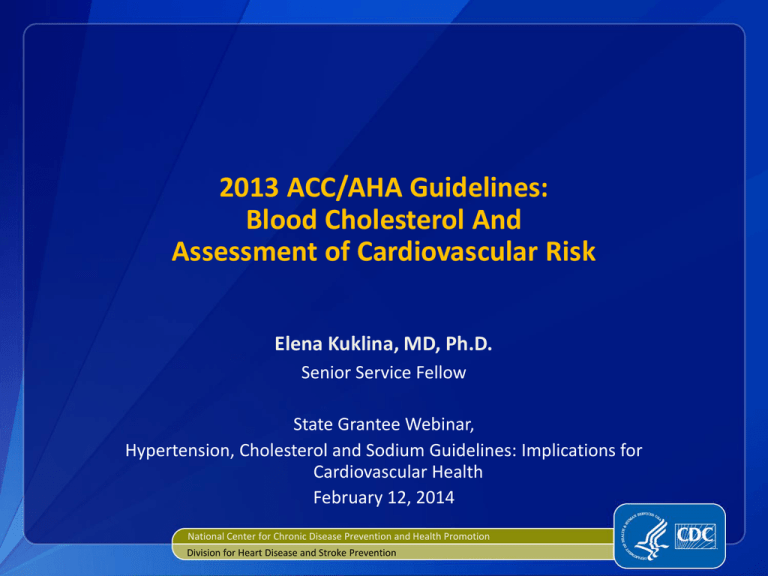
2013 ACC/AHA Guidelines:
Blood Cholesterol And
Assessment of Cardiovascular Risk
Elena Kuklina, MD, Ph.D.
Senior Service Fellow
State Grantee Webinar,
Hypertension, Cholesterol and Sodium Guidelines: Implications for
Cardiovascular Health
February 12, 2014
National Center for Chronic Disease Prevention and Health Promotion
Division for Heart Disease and Stroke Prevention
Background
ACC/AHA published new cholesterol and cardiovascular risk
assessment guidelines in 2013. 1
This is an overview of the 2013 ACC/AHA guidelines and a
comparison to preceding guidelines.
1. Goff DC, Lloyd-Jones DM, Bennett G, et al. 2013 ACC/AHA Guideline on the Assessment of Cardiovascular Risk: A Report of the American College of Cardiology/American
Heart Association Task Force on Practice Guidelines [published online ahead of print November 12 2013]. Circulation. 2013.
http://circ.ahajournals.org/content/early/2013/11/11/01.cir.0000437741.48606.98.citation. Accessed February 3, 2014.
ATP III Lipid and
Lipoprotein Classification
(The “Old Familiar Classification”)
LDL Cholesterol (mg/dL)
<100
100–129
130–159
160–189
190
Optimal
Near optimal/above optimal
Borderline high
High
Very high
Old vs. New: Lifestyle Modification
New guidelines:
Diet: healthy pattern
DASH, USDA , AHA Diet
Calorie requirements, personal and
cultural preferences, and nutrition
therapy for other medical
conditions
Old guidelines:
Diet: low fat and
low cholesterol
regular exercise habits
avoidance of tobacco products
maintenance of a healthy weight
Old vs. New: Statin Eligibility
Old
New
Age
Statin eligible
groups
1 ≥21 years
Clinical CVD
2 ≥21 years
LDL-C ≥190 mg/dl
3 40-75 years +LDLC 70-189 mg/dl
Diabetes
4 40-75 years + LDLC 70-189 mg/dL
High CVD risk
≥7.5%, 10 years,
CHD or stroke
Determining Risk for the 4th Group
New Pooled Cohort Equations to estimate 10-year risk
Adults 20-79 years of age who are free from ASCVD
4 racially and geographically diverse cohorts
ASCVD risk: heart disease and stroke
Calculated from sex, age, race, total cholesterol, HDL
cholesterol, systolic blood pressure, and whether on
treatment for high blood pressure, has diabetes, or is a
smoker
See Flowchart (addendum)
New: Classification of Statin Intensity
Intensity of statin therapy: is defined as a daily dose that
lowers LDL-C by
High-intensity: by 50%
Moderate-intensity: by 30% to <50%
New: Intensity Instead of Levels
What about the Rest?
There are people who may benefit from statin therapy who
do not fall into one of the four groups.
As with other guidelines, clinicians may use their judgment
in considering other factors such as:
• family history of ASCVD.
biomarkers such as C - reactive protein.
ankle-brachial index, etc.
Summary
Statin is the first line therapy.
Statin eligible groups based on benefit, not only on the LDLC measurement.
Treatment is based on statin intensity instead of specific
treatment goals for blood cholesterol.
New global risk assessment tool.
Healthy Dietary Patterns (servings per day unless
specified) (2000 kcal)
Implications
High cholesterol is a major and controllable risk factor for
heart attacks and strokes.
One goal of the ACC/AHA guidelines is to better identify and
focus statin therapy on those who are most at risk for (or
have) ASCVD.
Implications
We have much room for improvement for increasing the
level of healthy lifestyles and statin therapy even among
those most at risk.
We can use the guidelines to identify those who do not yet
know they are at risk, and increase healthy lifestyle choices
and statin therapy for those who are.
Program Considerations
New performance measures for cholesterol are in the
development phase.
Right now, we can:
Increase adaptation of healthy lifestyle and levels statin
therapy for those who do know they are at risk.
Help them adhere to that therapy for the rest of their longer
lives.
Sources
Goff DC, Lloyd-Jones DM, Bennett G, et al. 2013 ACC/AHA Guideline on the Assessment of
Cardiovascular Risk: A Report of the American College of Cardiology/American Heart
Association Task Force on Practice Guidelines [published online ahead of print November
12 2013]. Circulation. 2013.
http://circ.ahajournals.org/content/early/2013/11/11/01.cir.0000437741.48606.98.citati
on. Accessed February 3, 2014.
Stone NJ, Robinson J, Lichtenstein AH, et al. 2013 ACC/AHA Guideline on the Treatment of
Blood Cholesterol to Reduce Atherosclerotic Cardiovascular Risk in Adults: A Report of the
American College of Cardiology/American Heart Association Task Force on Practice
Guidelines [published online ahead of print November 12 2013]. Circulation. 2013.
http://circ.ahajournals.org/content/early/2013/11/11/01.cir.0000437738.63853.7a.citati
on. Accessed February 3, 2014.
Journal of American College of Cardiology. 2013.
http://www.sciencedirect.com/science/article/pii/S0735109713060282. Accessed
February 3, 2014
Education materials for patients
“Getting Healthy” by AHA:
https://www.heart.org/HEARTORG/GettingHealthy/Getting
Healthy_UCM_001078_SubHomePage.jsp
“Chose my plate” by USDA:
http://www.choosemyplate.gov/
“Lowering your blood pressure with DASH” by NIH”
https://www.nhlbi.nih.gov/health/healthtopics/topics/dash/
Thank you!
For more information please contact Centers for Disease Control and Prevention
1600 Clifton Road NE, Atlanta, GA 30333
Telephone: 1-800-CDC-INFO (232-4636)/TTY: 1-888-232-6348
Visit: www.cdc.gov | Contact CDC at: 1-800-CDC-INFO or www.cdc.gov/info
The findings and conclusions in this report are those of the authors and do not necessarily represent the official position of the
Centers for Disease Control and Prevention.
National Center for Chronic Disease Prevention and Health Promotion
Division for Heart Disease and Stroke Prevention

